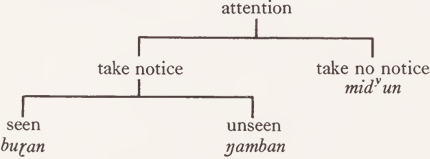
APPENDIX 1 - NEGATION
 المؤلف:
R. M. W. DIXON
المؤلف:
R. M. W. DIXON
 المصدر:
Semantics AN INTERDISCIPLINARY READER IN PHILOSOPHY, LINGUISTICS AND PSYCHOLOGY
المصدر:
Semantics AN INTERDISCIPLINARY READER IN PHILOSOPHY, LINGUISTICS AND PSYCHOLOGY
 الجزء والصفحة:
468-25
الجزء والصفحة:
468-25
 2024-08-20
2024-08-20
 1179
1179
APPENDIX 1 - NEGATION
The negative particle, gulu, can be looked upon as a semantic operator, that effectively replaces a feature in a semantic description by another feature from the same system. A simple example will illustrate this.
In text XXXIb, a girl goes out after dark in search of a mythical spirit, despite repeated warnings not to. There is in the text a pattern of semantic replacement1 involving essentially gulu ŋamban (bala bayumanganu guwal) ‘ didn’t listen (to what they were all saying) ’ and midyuganinyu ‘ repeatedly took no notice ’. In this instance the semantic replacement marks a relation of effective synonymy (in a particular context): gulu ŋamban has the same meaning as would midyun; midyuganinyu merely repeats, with the addition of -ganiy ‘kept on doing it’.
The dependency tree for set 4 is:

Now we are regarding gulu as an operator that replaces a feature in a semantic description by another feature from the same system (the other feature if it is a binary system). So that here gulu plus (attention, take notice, unseen; tr) is effectively (attention, take no notice; tr): gulu operates on feature ‘ take notice’, replacing it by ‘ take no notice ’ (no choice from system (seen, unseen} is possible after a ‘ take no notice ’ choice). However gulu ŋambart ‘ didn’t hear ’ and buɽan an ‘ saw ’ have also been observed in semantic replacement relation in Dyirbal texts. In this case gulu plus (attention, take notice, unseen; tr) is effectively (attention, take notice, seen; tr): gulu leaves alone ‘take notice’ but operates on ‘unseen’, replacing it by ‘seen’.
Generally, gulu ‘not’ can operate on any feature in a semantic description. Its precise operation in a particular instance can be inferred from semantic oppositions and replacements in the text (contextual correlations in the sense of Dixon 1965.111-7), or from the situational or other information available to a listener.
1 That is, there is a replacement correlation - see Dixon 1965.115-7 ff.; and compare n. a, p. 453 and n. a, p. 456, above.
 الاكثر قراءة في Semantics
الاكثر قراءة في Semantics
 اخر الاخبار
اخر الاخبار
اخبار العتبة العباسية المقدسة


